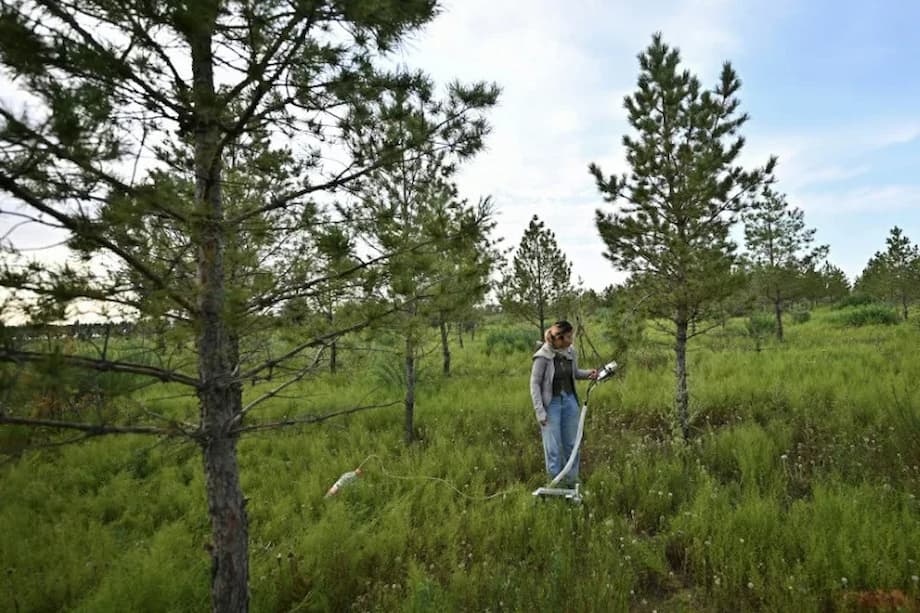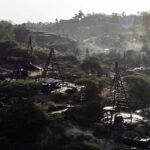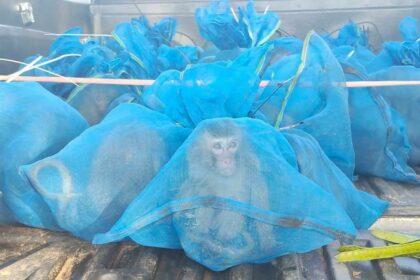A vast experiment in slowing the sands
Across northern China, an immense ecological project has tried to tame drifting dunes and revive drylands. The Great Green Wall, launched more than four decades ago, is credited with greening more than 90 million hectares. It began as an effort to halt the march of deserts that had advanced under the pressure of intensive farming, grazing, mining, and a warming climate. The program has since evolved, blending classic techniques such as tree and shrub planting with grassland restoration, straw checkerboards that trap sand, and even field scale solar installations that reduce wind speed and create shade for fragile seedlings.
Officials now present the initiative as a pillar of national climate and land policy. The government plans to expand tree and shrub cover between 2016 and 2050 by another 70 million hectares, an area similar in size to continental France. The national forestry administration says the Taklamakan, China’s largest desert, is now encircled by belts of vegetation. Leaders have linked the work to climate goals, with pledges to expand forest cover and curb dust storms that batter cities each spring. After years of effort, some indicators are moving in the right direction, although progress is uneven and the climate signal is intensifying.
In Inner Mongolia’s Kubuqi Desert, the transformation is visible. A United Nations assessment in 2015 found that planting the equivalent of 840,000 football pitches around Kubuqi created tens of thousands of jobs and eased poverty for nearby communities. New crops, tourism outfits, and solar energy facilities have followed green corridors. Yet that transformation has come with trade offs for pastoralists whose seasonal movements once shaped these grasslands. The same policies that stabilized dunes also imposed sweeping limits on traditional grazing and reshaped local culture. The result is a complex story of environmental gains and social strain.
The human side of the greener frontier
Herders in Inner Mongolia describe a new landscape of fences and checkpoints. Grazing bans, enforced by dedicated patrols, have reduced herd sizes and pushed many families to keep animals in small enclosures. Ethnic Mongolians, who make up roughly 17 percent of the region’s population, say a way of life built on nomadism and seasonal migration has receded. Protests and detentions have followed in places where long used pastures became off limits. Some researchers have also argued that earlier policies overstated the role of grazing in desertification compared to other drivers like mining, intensive agriculture, and drought linked to climate change.
Who bears the cost for stricter grazing rules?
Activists argue that many herders were asked to absorb the burden of repairing ecosystems they did not primarily degrade. They point to heavy industrial water use, poorly planned farming, and extraction projects that scarred land at scale. For families who moved frequently to match grass growth and rainfall, a static grazing ban removed the flexibility that once kept forage pressure in balance with the land.
Enghebatu Togochog, a Mongolian rights advocate in exile, argues that the campaign has reordered the region’s culture and economy in ways that benefit outside interests more than local herders.
“The sole beneficiaries are the Chinese, especially the state and the companies,” he said.
Herders name another change that complicates dialogue: the chilling effect of constant monitoring. Visitors to sensitive areas report being shadowed by local staff, which discourages candid discussion. Taken together, tighter enforcement, fewer grazing options, and a diminished voice in land management have eroded trust. Many communities ask for a shift from blanket bans toward adaptive rules that reflect local rainfall, plant cover, and the traditional knowledge of moving herds with the seasons.
Does greening every desert make sense
Ecologists caution that turning dunes into plantations is not a one way solution. Species that are poorly matched to dry conditions can fail after a few seasons, and irrigation in arid zones can drain shallow aquifers. Deserts also provide services that are often overlooked, such as water storage in sand, unique biodiversity adapted to harsh conditions, and reflective surfaces that influence local climates. The goal, several experts say, is to stop expansion of degraded land rather than to erase desert ecosystems.
Zhang Yanping, an environmental scientist who samples long planted stands in the Kubuqi, warned about the risks of thirsty trees in places with limited recharge.
“A plant that consumes too much water can deplete the water table and lead to further degradation,” she said.
Wang Shuai, a geography professor at Beijing Normal University, argues for a more selective approach that protects deserts where they function well and restores areas that are damaged or mobile.
“The instinct to convert desert into greenery is not always the right one,” he said. “Deserts have important ecological functions, like water conservation and biodiversity. It is not necessary to eliminate them, just to prevent their expansion.”
How straw checkerboards work
A technique pioneered in China, the straw checkerboard, has become a signature of anti desertification efforts. Workers lay bundles of straw in a grid pattern over bare sand. The rough surface reduces wind speed at ground level, traps moving grains, and gives seedlings a chance to take root. Once the sand is stabilized, planters introduce hardy shrubs and trees adapted to dryness, such as sacsaoul, which can survive on scant water and anchor dunes with deep roots.
In Inner Mongolia’s Alxa, officials completed a continuous sand control belt across three deserts, the Badain Jaran, Tengger, and Ulan Buh. The belt, which stretches about 1,856 km, aims to connect local barriers into a broader ecological shield. Explaining the method, Zhang Youyong, chief engineer at the local forestry and desert control bureau, said the sequence matters.
“We use the straw checkerboard method to first lock the shifting sand, followed by planting drought resistant trees such as sacsaoul. This approach helps us build an effective sand prevention and control system, ultimately strengthening the ecological barrier,” he said.
Large belts like this can cut wind erosion and reduce sand that reaches farmland and towns. The challenge is long term maintenance and matching species to microclimates. Mixed plantings, promoting natural regrowth where possible, and careful water budgeting improve survival and keep new vegetation from becoming a temporary green flush that fades after incentives end.
Jobs, incomes, and new businesses
The Great Green Wall is also an economic story. A United Nations review linked Kubuqi’s greening to tens of thousands of jobs. Officials and local entrepreneurs often describe a chain reaction: stabilized dunes allow for planting of shrubs that have market value, restored shelter creates zones where crops can grow, and improved access draws visitors to once barren landscapes.
One such crop is Cistanche, a parasitic herb prized in traditional medicine. It anchors to host roots and thrives in sandy soils. Near Dengkou county, farmer Bai Lei says it helped turn sand into opportunity. She recalled the starting point in simple terms.
“Before, everything here was desert,” she said.
Tourism has grown alongside these new plantings. A former farmer named Feng now runs quadbike outings on tracks near areas under restoration. He describes a turning point after grazing limits gave seedlings a chance to mature and spread seed.
“Resources are more abundant, and our lives are more prosperous,” he said. “We can hold our heads up with pride.”
Income gains are not universal, and they often come with a trade off. Some households that benefited from planting and tourism once relied on mobile herding. Others have moved into maintenance roles for shelterbelts or work with solar operators. The shift highlights a central tension of the project: how to improve livelihoods and restore land while preserving cultures built on mobility.
Sandstorms, climate pressure, and tracking progress
Dust events remain a stubborn threat. Northern China’s spring skies still turn yellow on bad days, and climate change is adding heat and drying that stress grasslands. National data show fewer severe spring sandstorms compared with the late twentieth century, yet recent years have brought spikes that remind residents the problem is not solved. During a visit to Inner Mongolia, President Xi Jinping urged officials to stay focused, linking recent increases in dusty weather to climate forces and calling for perseverance in a fight that will be long term and demanding.
Official statistics say that more than half of treatable desertified land is now under effective control. Remote sensing studies also suggest that from the late 1990s to the mid 2010s, dunes in some regions retreated. At the same time, independent assessments warn that reported gains can mix natural regrowth, young plantations, and areas without a continuous canopy, which can overstate long lasting forest cover. The quality of restoration matters as much as the quantity. Planting that reduces soil moisture or lowers water tables can undermine resilience. Natural regeneration and assisted recovery often store more carbon and require less maintenance than monoculture plantations.
Beyond China’s borders, the United Nations Convention to Combat Desertification promotes Land Degradation Neutrality, a framework to balance land losses and gains. Analysts studying Mongolia and China’s northern provinces recommend policies that reflect the region’s shared climate and dust sources. They list heavy grazing pressure in places, land conversion, and mining as chronic drivers of degradation. Coordination on both sides of the border can strengthen early warning, restore corridors for mobile herding, and align restoration so that gains in one country are not offset by losses in another.
Solar arrays at the desert edge
Renewable energy is now part of the greening playbook. In the Kubuqi and nearby Ordos region, developers have built vast photovoltaic fields. Panels curb wind at ground level, shade seedlings, and generate clean electricity that can flow through ultra high voltage lines to urban corridors. Project plans describe a linked set of solar bases running for hundreds of kilometers across sandy margins, with capacity targets that would place Inner Mongolia at the center of China’s renewable power buildout.
Some proposals refer to a Great Solar Wall across stretches of the Kubuqi that would produce tens of billions of kilowatt hours per year once complete. The concept pairs elevated panels with vegetation and even small scale crops beneath the arrays. That model spreads benefits, turning erosion control sites into power plants and farm plots. Engineers are testing bifacial modules that absorb reflected light and tracking systems that optimize tilt as the sun moves. Energy storage and green hydrogen pilots are also emerging so that daytime generation can serve nighttime demand. These projects promise jobs and lower emissions, yet they also require careful siting to avoid shading out native plants and to protect scarce water.
Science based restoration and policy shifts
Decades of trials have refined what works in arid landscapes. Mixed plantings outperform single species belts. Local species, such as sacsaoul and drought adapted shrubs, survive better than fast growing exotics. Allowing natural regrowth where seed sources remain can be slower at first but more durable. Comprehensive water budgeting helps avoid a common failure mode, when thirsty plantations outpace groundwater recharge. Monitoring beyond a short project cycle, and funding maintenance beyond early years, are essential.
Rethinking grazing bans
Research from Chinese academics has argued that policies sometimes overstated the role of herds in causing desertification and understated the value of mobile grazing systems. Where rainfall is variable, moving animals allows plants to recover and keeps pressure in line with what the land can support. In several restored zones, authorities already allow seasonal grazing after plants establish and begin to seed. Expanding that adaptive approach, with local input and science based thresholds, could reduce conflict while protecting new vegetation. Pairing herder knowledge with satellite monitoring and ground surveys would help managers decide when land is ready for grazing and when it needs more time to recover.
Key Points
- China’s Great Green Wall has greened more than 90 million hectares through tree, shrub, and grassland restoration in desert margins.
- Officials plan to expand cover by another 70 million hectares between 2016 and 2050, and say the Taklamakan is encircled by vegetation belts.
- In Kubuqi, a United Nations study linked greening to tens of thousands of jobs and poverty reduction, with new crops and tourism businesses taking root.
- Stricter grazing rules have reduced mobility for herders in Inner Mongolia, with activists saying costs fell heavily on pastoral communities.
- Chinese researchers argue that mining, intensive farming, and climate forces have also driven desertification, and that grazing impacts were sometimes overstated.
- Ecologists warn that water intensive or non native plantings can lower water tables, while deserts also provide vital ecological functions.
- A sand control belt of about 1,856 km now links the Badain Jaran, Tengger, and Ulan Buh deserts, using straw checkerboards and hardy desert species.
- Dust events have eased across long time scales but remain frequent, and leaders urge sustained work as climate change adds stress.
- Large solar bases in Inner Mongolia pair erosion control with clean power, promising jobs and electricity while requiring careful siting to protect ecosystems.
- Best practice now favors local species, mixed planting, natural regeneration, and adaptive grazing that reflects local conditions and herder knowledge.












